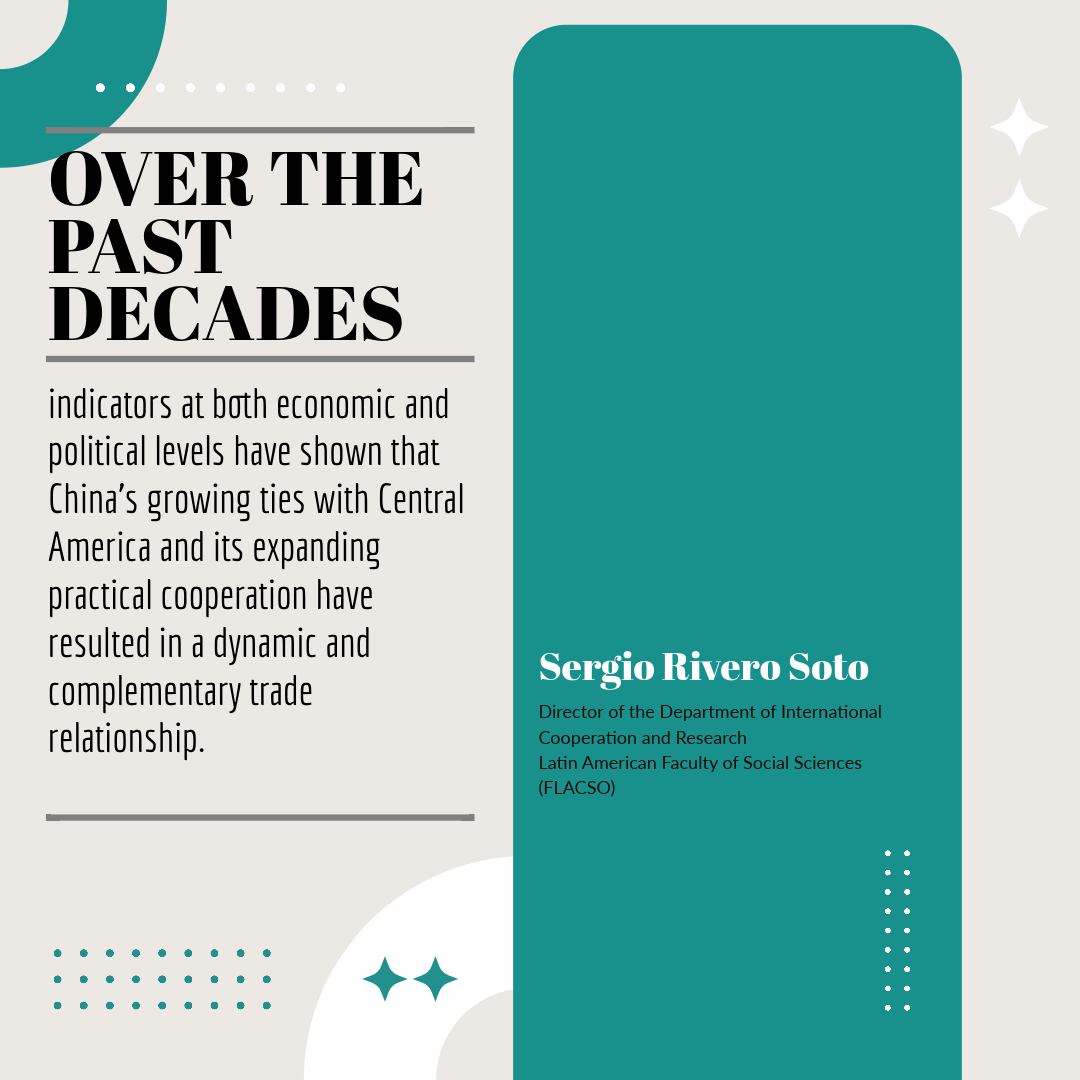


Marvelous economic and social development has been achieved over the past decade in China, whose fundamental goal lies in realizing national prosperity and wealth and the great rejuvenation of the Chinese nation. Looking back on this decade, China’s foreign policy not only upholds the basic principle of maintaining world peace, but also strongly supports global governance, the multilateral trading system and economic globalization. The past decade has seen growing ties between China and the world. From the Central American perspective, though thousands of miles apart, we could feel strongly the growing cooperation and ties with China.
The Communist Party of China celebrated its centennial in 2021. It was also a very important year for Central American countries, celebrating both the 200th anniversary of independence and the 30th anniversary of the Central American Integration System (SICA). For developing countries, the importance of international economic relations goes far beyond diplomatic objectives in the traditional sense. It is true that the economies of Central American countries are highly dependent on US trade and investment, but fortunately, the 30-year history of SICA has coincided with a global economy characterized by the rise of China in a multipolar world. Over the past decade, economic and trade relations between Central American countries and China have grown rapidly, resulting in a closer bond than ever before.
In December 1985, Nicaragua became the first Central American country to establish diplomatic relations with the People’s Republic of China. After the right-wing party took power in Nicaragua in 1990, its relationship with Taiwan was resumed, hence China terminated its diplomatic ties with Nicaragua. With the changing international landscape, the Nicaraguan government made a major political decision in December 2021 to restore diplomatic relations with the People’s Republic of China, recognizing that there is only one China in the world, that the government of the People’s Republic of China is the sole legitimate government representing all of China, and that Taiwan is an inseparable part of China. In 2007, Costa Rica established diplomatic relations with the People’s Republic of China, a landmark event in the history of Costa Rica after which the country was integrated into the world economy and its international status was greatly enhanced. As the then President of Costa Rica, Arias Sánchez, said, the support for the “One China” principle was a rational diplomatic decision not motivated by short-term economic interests or ideological influences.
Since the 1990s after Costa Rica became the first Central American country to recognize the government of the People’s Republic of China as the sole legitimate government representing all of China, Panama, the Dominican Republic and El Salvador have also consolidated their relations with China, establishing diplomatic relations with China in June 2017, May 2018 and August 2018, respectively. These initiatives reflect the strong will of the region to strengthen exchanges with China and deepening cooperation in political, economic and trade dimensions. It also shows that some developing countries that have long been dependent on the US are making new choices in the new international landscape. In this sense, the diplomatic choices of Central American countries have provided a new angle for understanding China’s relations with the world.
The economic and trade relations between Central American countries and China predate their diplomatic relations. In the 1990s, countries such as Panama and the Dominican Republic signed a series of agreements with China to set up trade development offices, effectively promoting bilateral investment, trade and tourism. The past decade has seen a period of rapid development of such relations. In August 2011, the free trade agreement signed between Costa Rica and China officially entered into force. Within this framework, remarkable achievements have been made for more than a decade, and in addition to traditional economic and trade exchanges, both sides have strengthened cooperation in technology transfer, educational service and sustainable development. Panama, with its canal, enjoys unique conditions and is therefore the Central American country that receives the most Chinese investments. According to Panama’s statistics on freight traffic, China has become the second largest customer of the Panama Canal after the US. Countries such as El Salvador and Guatemala are also becoming more active in their economic and trade interactions with China, and their exports to China have been rising in recent years. According to SICA, China is one of the most important export destinations, accounting for more than 20% of SICA’s exports; China is also one of the most important sources of imports for Central America, with 58% of Central American purchases in Asia coming from China.
For all Latin American and Caribbean countries, especially for Central America, the rising protectionism in the US poses a serious threat to economic growth and national development. Fortunately, the initiatives and cooperation programs pursued by China offer viable options for trade diversification. International trade is an important pillar of the Central American economy, yet the lack of investment in quality infrastructure severely limits its integration into global supply and value chains. The “Belt and Road Initiative” is an international project with infrastructure development as one of its priorities, offering great opportunities for sustainable infrastructure investment and economic growth in Central America. Currently, Panama, Costa Rica, El Salvador, Dominican Republic and Nicaragua have all signed cooperation agreements with China to jointly build the “Belt and Road Initiative”. The complementarity in trade between Central America and China provides space and vitality for bilateral cooperation. In addition, Central America has the geographical advantage of global trade and can become not only a logistics and trade hub between China and the entire Latin American and Caribbean region, but also with the world, bringing the Americas closer to the Asia-Pacific region.
Over the past decade, indicators at both economic and political levels have shown that China’s growing ties with Central America and its expanding practical cooperation have resulted in a dynamic and complementary trade relationship. The 20th National Congress of the CPC is just around the corner, this meeting will not only be significant for China but also have far-reaching implications for the world. We see it as an opportunity to further enhance friendship and strengthen bilateral relations with China. We look forward to the continued deepening of practical cooperation so we can jointly promote economic and social development and build a better community of shared future for mankind.
Contributed by Sergio Rivero Soto (Costa Rica), Director of the Department of International Cooperation and Research, Latin American Faculty of Social Sciences (FLACSO)

点击右上角![]() 微信好友
微信好友
 朋友圈
朋友圈

请使用浏览器分享功能进行分享
